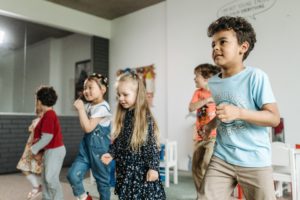They’re not listening to me!
It’s a common complaint, especially when working with kids (though it’s said about adults, too!).
I’m always fascinated by it. When the person is asking for help with the “problem,” I first ask, “Are you telling them what to do?” The response varies from “Well, yeah!” to “What do you mean by that?”
What do I mean?
I recently had the opportunity to return to a site for a few weeks—from beginning to end of the school day—and it has me thinking about what it means to lead with care rather than control.
 The first thing I did with the first and second graders was get to know them by name and discover what sparks their curiosity and engagement. I care deeply about kids experiencing joy and meaningful relationships and creating conditions where they can heal and thrive. We had many conversations, both impromptu and within planned engagements. I was intentional in all interactions to really see each one of them and to leverage their voices and ideas so our experiences felt collaborative.
The first thing I did with the first and second graders was get to know them by name and discover what sparks their curiosity and engagement. I care deeply about kids experiencing joy and meaningful relationships and creating conditions where they can heal and thrive. We had many conversations, both impromptu and within planned engagements. I was intentional in all interactions to really see each one of them and to leverage their voices and ideas so our experiences felt collaborative.
We started early on talking about the importance of safety (both physical and emotional) and what it meant to be a community. The kids understood community to mean friends working together. They already had a code word for physically distancing: “bubbles.” When we talked about how we wanted to treat each other, there was instant consensus around being kind. Our group promises, or what we call Community Agreements at LA’s BEST, grew out of these conversations. We wrote them up for everyone to see and added fun pictures that reflected each of our identities.
 Throughout our daily work together, I sought opportunities to connect back to our Community Agreements as they expanded and became more relevant. I made sure to never use the Community Agreements as a means to control the group of young people, but rather stressed the importance of how much I cared about them when they made a choice that was unsafe or wasn’t in keeping with our Agreements.
Throughout our daily work together, I sought opportunities to connect back to our Community Agreements as they expanded and became more relevant. I made sure to never use the Community Agreements as a means to control the group of young people, but rather stressed the importance of how much I cared about them when they made a choice that was unsafe or wasn’t in keeping with our Agreements.
An example: I’m not too big on making kids walk in a straight line, so it was common for my students to quietly move through the hallways like their favorite animal or to complete a special mission to the restroom while discussing an interesting question with a buddy. We consistently made it safely from point A to B, all while staying mindful of our “bubbles.” When it came time to do a fire drill, however, we talked about what we were going to do to ensure that we and everyone around us stayed safe. It became clear to the group early on that since everyone in the school would be going outside at one time, it made sense to walk in a line and get to the assigned destination. The group did great! Toward the end of the day, one of my colleagues mentioned that they were surprised to see our group walking in a line during the drill—since we didn’t seem to know how to do it other times. My response was simply that the students recognized the importance for walking in a line during the drill.
 It makes me sad when a group or individual is listening to their “leader” out of fear of what might happen if they don’t—the whole “or else!” factor. Pain and shame thrive here. There are some serious misconceptions around this dynamic, such as that a strong leader is one who can control a group. This couldn’t be further from the truth. Strength comes when we are willing to be vulnerable and make real connections with other people.
It makes me sad when a group or individual is listening to their “leader” out of fear of what might happen if they don’t—the whole “or else!” factor. Pain and shame thrive here. There are some serious misconceptions around this dynamic, such as that a strong leader is one who can control a group. This couldn’t be further from the truth. Strength comes when we are willing to be vulnerable and make real connections with other people.
I’m guessing most, if not all of us, knows what it feels like when someone is telling us what to do—especially someone who has real or perceived power over us. It’s usually not a great feeling. And I’m guessing most, if not all of us, knows what it feels like when someone cares about us and is willing to authentically listen to our needs and perspectives. It’s meaningful. It has an impact.
When others “aren’t listening to me,” I ask myself first if I’m listening to them. And that is never more true than when I’m working with young people in this beautiful field of ours. Leading by caring can be much more effective—and rewarding—than trying to control. As we’ve learned this past pandemic year, we can’t control a lot of things—aside from how we choose to show up and care.
For breakfast, I had the usual – one hard-boiled egg, celery and peanut butter sticks, and two large glasses of water.
Author: @zachwilson
